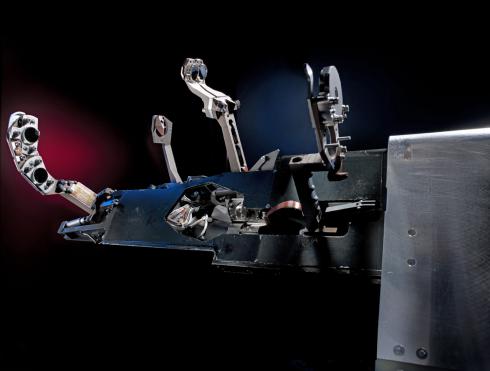
How can human spaceflight become routine, economical, practical and safe? How can a home and workplace be created in the extreme environment of space? What does the future hold for humans in space? Will people be able to travel to far-away worlds beyond the moon? Do the benefits of human spaceflight outweigh the risks and expense?
"Moving Beyond Earth," a new exhibition at the National Air and Space Museum, asks visitors to consider these questions and encourages them to follow the developing story of humans in space. The first stage of “Moving Beyond Earth” opens today, with 25 historical artifacts, a presentation center, two wall-size projections and six decision-making interactive displays. When completed in late 2011, the exhibition will highlight the space shuttle and international space station and look beyond to the various possibilities for future space exploration.
"People always ask us what spaceflight is 'really like,'" said Gen. J.R. "Jack" Dailey, director of the museum. "Our new exhibit ‘Moving Beyond Earth’ combines artifacts with computer-based interactives and live presentations to answer that question and inspire visitors of all ages."
"NASA and the Smithsonian capture the imagination of people everywhere across this great nation," said Lori Garver, NASA deputy administrator. "This new exhibition will inspire curiosity and create interest, especially for our young people, to go into science, technology, engineering and math careers."
The artifacts on display reflect the exhibition’s three main themes: Moving into Space, Living and Working in Space and Envisioning our Future in Space. A 12-foot-tall space-shuttle model and other launch-vehicle models represent the quest for routine access to space. The Corrective Optics Space Telescope Axial Replacement, COSTAR, brought back from the Hubble Space Telescope on the STS-125 mission, and the HST Power Control Unit Trainer, used by astronauts to practice the difficult task of replacing the electrical nerve center of the HST, convey the challenges of working in space, while the suit worn by space tourist Dennis Tito and a model Ares launch vehicle suggest future prospects for commercial spaceflight to the moon.
As visitors walk through the gallery, they are placed “in orbit” by an expansive view of the Earth that drifts over one gallery wall, while a fly-around tour of the international space station fills another wall. A presentation stage for live events, broadcasts and webcasts at the center of the gallery serves as the platform for SpaceFlight Academy, a group quiz game where visitors can test their space smarts and become "flight ready."
Visitors can also experience aspects of spaceflight through interactive computer kiosks where they can serve as mission control’s flight director to keep a shuttle mission on track, equip a new module for the space station, manipulate and assemble space-station elements, explore the moon and Mars and match visitors’ interests to jobs in the spaceflight workforce.
Support for "Moving Beyond Earth" is provided by NASA.
The National Air and Space Museum building on the National Mall in Washington, D.C., is located at Sixth Street and Independence Avenue S.W. The museum’s Steven F. Udvar-Hazy Center is located in Chantilly, Va., near Washington Dulles International Airport. Both facilities are open daily from 10 a.m. until 5:30 p.m. (closed Dec. 25). Admission is free, but there is a $15 fee for parking at the Udvar-Hazy Center.
Corrective Optics Space Telescope Axial Replacement (COSTAR), "Contact Lenses for the Telescope," on display at the new "Moving Beyond Earth" gallery in the National Air and Space Museum's Mall building.
Soon after its launch in 1990, scientists realized that the Hubble Space Telescope’s large primary mirror was flawed. It distorted images and data, making everything blurry. Shuttle crews installed this corrective optics package, called COSTAR, in 1993 and returned it to Earth in 2009.
Shuttle astronauts used this trainer to practice the difficult task of replacing the Power Control Unit, the electrical nerve center of the Hubble Space Telescope, on a 2002 servicing mission. This artifact is on display at the "Moving Beyond Earth" exhibition at the National Air and Space Museum's Mall building.
Gloves are a crucial part of the pressurized spacesuits worn to work in space. Gloves must be flexible enough for fingers to feel and move well, yet strong enough not to leak air or rip.
These Shuttle EVA gloves and Sokol pressure-suit glove are on display in the Moving Beyond Earth exhibition at the National Air and Space Museum's Mall building.